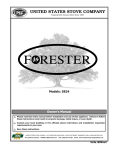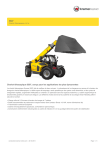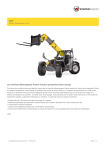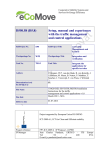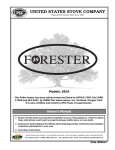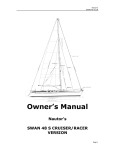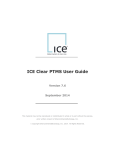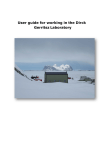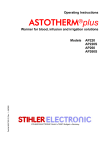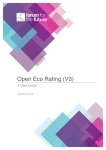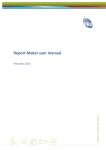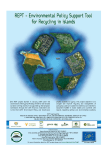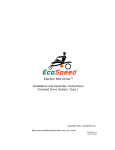Download ECORegion
Transcript
ECORegion ECORegion is… " " " " An internet based software solution for the accounting of energy consumption and greenhouse gas emissions of cites, communes, provinces and states A monitoring and szenario platform A data and benchmark pool THE standard for right balancing and reporting ! Input table with check up charts ECORegion offers… " " " " " A start balance on national key data A comparable structure for all clients A community-platform to manage city networks A cockpit to administer data, users, access, licences, calculations, szenario, etc. Training courses, online and pdf help, support hotline ! Own Balance and Benchmark ECOSPEED Ltd, Gerechtigkeitsgasse 20, CH-8002 Zürich T +41-44-493-93-00, F +41-44-493-93-09, www.ecospeed.ch, [email protected] ECORegion raises… " " " " " The image and reporting possibilities The quality of evaluations of measures and investments The transparency of political decisions Knowhow saving if people leave The data security (daily backup) ! Cockpit ECORegion saves… " " Time, because all calculations, factors, methods are already implemented Costs, because the balances are faster, transparent and have more possibilities for the reporting ! Szenario until 2030 ECORegion is available… " " ! Website as Version „smart“ o Monitoring o End und Primary energy consumption o CO2-Emissions as Version „pro/premium“ o Monitoring und Szenario o End und Primary energy consumption o All greenhouse gases (also non energetical emissions) ECORegion is growing… " " " " Through permanent implementation of new features Through permanent adaption of benchmarks Through new languages Through our expanding team ECOSPEED Ltd, Gerechtigkeitsgasse 20, CH-8002 Zürich T +41-44-493-93-00, F +41-44-493-93-09, www.ecospeed.ch, [email protected] ECORegion Short Instruction Zurich, October 1, 2009 ECOSPEED AG, Gerechtigkeitsgasse 20, CH-8002 Zürich, T +41-44-493-93-00, F +41-44-493-93-09 www.ecospeed.ch, [email protected] Overview “Documents ECORegion“ ECORegion – Flyer ! ! ! ! ! Contents Examples Methodology Features Costs ECORegion – Short Instruction ! ! ! ! ! The 6 central steps Registration and ordering on www.ecospeed.ch Set-up of the starting balance Set-up of the final balance Tips for the reporting ECORegion – Methodologies ! ! Balances after IPCC methodology Balances after LCA methodology ECORegion – Manual ! pdf-version of the online-help ECORegion – Communities ! ECORegion – Short Instruction Case studies of city networks, provinces, counties that are using ECORegion as their standard. Seite 2/12 Content FIVE STEPS ................................................................................................................................... 4 1 REGISTRATION (STEP 1) ......................................................................................................... 5 2 ORDERING (STEP 2) ............................................................................................................... 5 3 START BALANCE (STEP 3) ....................................................................................................... 6 4 3.1 BASIC INFORMATION...................................................................................................................... 6 3.2 NEEDED DATA .............................................................................................................................. 6 3.3 CALCULATION ............................................................................................................................... 6 3.3.1 Household sector.............................................................................................................................................. 6 3.3.2 Economy sector ................................................................................................................................................ 6 3.3.3 Transportation sector ....................................................................................................................................... 6 3.3.4 Factors.............................................................................................................................................................. 7 FINAL BALANCE (STEP 4) ........................................................................................................ 8 4.1 BASIC INFORMATION...................................................................................................................... 8 4.2 OPTIONAL INPUT OF OWN DATA ....................................................................................................... 8 4.3 BOTTOM-UP DATA......................................................................................................................... 8 4.3.1 Energy carriers for all facilities ......................................................................................................................... 8 4.3.2 Split of energy consumption into household and economy sector ................................................................. 10 4.3.3 Energy consumption for governmental facilities............................................................................................ 10 4.3.4 Driven kilometers ........................................................................................................................................... 11 4.3.5 Electricity mix and district heat mix ............................................................................................................... 11 4.4 5 TIPS .......................................................................................................................................... 11 REPORTING (STEP 5) ............................................................................................................ 12 ECORegion – Short Instruction Seite 3/12 Five steps Registration ! ! You register on www.ecospeed.ch for ECORegion. The registration is free of costs. Ordering ! ! You order ECORegion online after the first login. The prices are different depending on the bought license and on the numbers of inhabitants of the region. Start Balance ! ! ! After the ordering you can directly start with entering data. In this first phase ECORegion needs the number of inhabitants and number of employees of your region. After entering the basic data you can calculate per mouse click the first complete starting balance. Final Balance ! ! The starting balance finally can be calibrated with own data where they are available. The detailed process can be read in the manual. You find tips and tricks in this document (chapter 5). Reporting ! ! ECORegion – Short Instruction After finishing the balance the results normally have to be reported to different audits (politicians, experts, media, etc.). We give you tips what have to be considered for a good and consistent reporting within this document. Seite 4/12 1 Registration (step 1) First you have to register for ECORegion on www.ecospeed.ch. You get username and password immediately per Mail and therefore already get access to the cockpit of ECORegion with the following options: ! Administration (own logo, defining new user, etc.) ! All documents (tutorial, FAQ, User Manual, etc.) You get a first impression of the tool without paying anything. 2 Ordering (step 2) ECORegion needs the following information during the process of ordering: ! Country ! Name and Adress ! Number of inhabitants ! Choice of the needed license ! Membership in a predefined network (could give discount) ! Number of years You have to accept the conditions to finalize the ordering process. In a few second you get a confirmation of your registration per mail. After that you can immediately start with the data implementation (see chapter 3). ECORegion – Short Instruction Seite 5/12 3 Start Balance (step 3) 3.1 Basic Information The start balance is a top-down approach based on national per capita key factors. The starting balance can be characterized over the following points: ! Time needed for the start balance: 2-6 hours ! Difference to bottom-up approach: < 10% ! Possibility to calibrate with own bottom up data 3.2 Needed Data You start with the implementation of the basic data: ! Number of inhabitants ! Number of employees With these data ECORegion will calculate based on national per capita key data a first balance (see chapter 3.3). 3.3 Calculation 3.3.1 Household sector ECORegion is calculating the energy consumption for the household sector out of the number of inhabitants of the region and the national per capita energy consumption per energy carrier. These per capita key data are coming from the national dataset which is updated every year by Ecospeed. 3.3.2 Economy sector ECORegion is calculating the energy consumption for the economy sector out of the number of employees after 17 different economy sectors and the related national per capita energy consumption per energy carrier. The per capita key data are coming from the national dataset which is updated every year by Ecospeed. This method allows to takes different economic structures into account. The calculated energy consumption afterword is aggregated to the main three economy sector (agriculture, industry, services). 3.3.3 Transportation sector ECORegion is calculating the number of driven kilometers per vehicle type out of the number of inhabitants and the number of employees and the national per capita kilometer per vehicle type. ECORegion at the moment has per capita data on countrylevel. It is planned to implement these data also for different types of regions like urban or rural areas. ECORegion automatically delivers the fuel-mix and the specific energy consumption per vehicle type. ECORegion – Short Instruction Seite 6/12 3.3.4 Factors The following factors are delivered automatically and are always updated in ECORegion for every country: ! Emission factors for greenhouse gas emissions per energy carrier on the level of final and primary energy consumption ! Emission factors for air pollutants per energy carrier ! Factors for ecobalance points per energy carrier ! Factors for the calculation of primary energy consumption per energy carrier ECORegion – Short Instruction Seite 7/12 4 Final Balance (step 4) 4.1 Basic Information The final balance is a bottom-up approach based on own data of the region. The final balance can be characterized over the following points: ! Time needed for the final balance: 2-10 days ! Focus lays on the input of energy consumption and driven kilometers. The rest (LCA-balance, emissions, air pollutants, ecobalance, etc.) is delivered by mouse click. 4.2 Optional input of own data ! Energy consumption per energy carrier for all facilities ! Split of this energy consumption into household sector and the three different economy sectors ! Energy consumption for the governmental facilities ! Driven kilometers per vehicle type ! Number of vehicles ! Electricity mix and district heat mix ! Emission factors (electricity products, district heat products, rest of energy carriers) With these data ECORegion will calculate the all related output tables and charts. 4.3 Bottom-up data 4.3.1 Energy carriers for all facilities 4.3.1.1 Electricity consumption The electricity consumption in your region normally is known. The data are delivered by the own electricity company or the one which delivers the electricity to the region. These data normally are also available seperately for the household and economy sector. The data security normally is no problem on the level ECORegion needs these data. If the electricity company does not deliver these data, it is possible to implement this point when the contract with this company is renewed. 4.3.1.2 Natural gas The consumption of natural gas in your region normally is known. The data are delivered by the own gas company or the one with which delivers the gas to the region. These data normally are also available separately for the household and economy sector. The data security normally is no problem on the level ECORegion needs these data. If the gas company does not deliver these data, it is possible to implement this point when the contract with this company is renewed. ECORegion – Short Instruction Seite 8/12 4.3.1.3 District heat The consumption of district heat in your region normally is known. The data are delivered by the own district heat company or the one which delivers the district heat to the region. These data normally are also available separately for the household and economy sector. The data security normally is no problem on the level ECORegion needs these data. If the district heat company does not deliver these data, it is possible to implement this point when the contract with this company is renewed. 4.3.1.4 Crude oil The consumption of crude oil in your region normally is not known. If you want to get own bottom-up data you have to calculate them over the available data of the chimney sweeper. They normally have data for the power for all plants which are burning crude oil, wood or gas. You just have to estimate the operating hours for these plants and then calculate the related energy consumption for these plants. If the calculated consumption of crude oil differs a lot from the one of the starting balance, you have to compensate the difference on the use of natural gas and vice versa. Otherwise you would over- or underestimate these consumptions. 4.3.1.5 Wood The consumption of wood in your region normally is not known. If you want to get own bottom-up data you have to calculate them over the available data of the chimney sweeper. They normally have data for the power for all plants which are burning crude oil, wood or gas. You just have to estimate the operating hours for these plants and then calculate the related energy consumption for these plants. If the calculated consumption of crude oil differs a lot from the one of the starting balance, you have to compensate the difference in that way, that the overall energy consumption for the facilities is not changing too much compared to the energy consumption of the starting balance. 4.3.1.6 Coal Coal normally is used above all for industrial processes or in the energy production sector. You get these data by asking the main companies in these fields about their coal consumption. 4.3.1.7 Geothermal energy The geothermal energy normally has to be estimated. The most important information for this estimation is the number of installed geothermal heating pumps and their power. These data can be gathered in different ways: 1. If someone wants to implement a heating pump in his building he needs to get the permission from the government for that. In this permission the planned power and the operating factor of this plant has to be declared. This information can be gathered and used for the estimation of the energy consumption. 2. If your region is supporting the construction of heating pumps financially, the related request should also ask for the information of the planned power and operating factor of the plant. ECORegion – Short Instruction Seite 9/12 4.3.1.8 Solar collector The solar heat normally has to be estimated. Most important for this estimation is the number of square meters of the existing solar collectors. These data can be gathered in different ways: 1. If someone wants to implement a solar collector in his building he needs to get the permission from the government for that. In this permission the planned square meters has to be declared. This information can be gathered and used for the estimation of the energy consumption. 2. If your region is supporting the construction of solar collectors financially, the related request should also ask for the information of the planned square meters of the collectors. 4.3.1.9 Biogas The share of biogas normally plays a role in the power generation and the fuel consumption in the transportation sector. Biogas normally is not used for direct use for heating buildings. The electricity company and the fuel company have the data for the use of biogas. Normally these data can be gathered from the annual reports of these companies. 4.3.1.10 Waste In this category the waste in counted which is burned directly (e.g. industrial processes like the production of cement). The use of waste in waste incinerations is not taken into account, because these information is part of the electricity mix and district heat mix. The data for the use of waste in the related processes are normally published by the industrial companies in their annual reports. 4.3.2 Split of energy consumption into household and economy sector To produce results for energy consumption and CO2-emissions on the level of households or economy sectors it’s necessary to define the shares of all sectors compared to the overall energy consumption for all facilities. It’s possible to define two shares: 1. Share per energy carrier of the household sector compared to the overall energy consumption for all facilities. 2. Share per energy carrier of the three economy sectors compared to the energy consumption for all facilities minus the energy consumption of the household sector. 4.3.3 Energy consumption for governmental facilities It is possible to implement bottom-up data for the governmental facilities for four different sub-sectors. ECORegion – Short Instruction Seite 10/12 4.3.4 Driven kilometers The driven kilometers in the transportation sector are separated into four categories: ! People transportation for short distances ! People transportation for long distances ! Goods transportation on the road ! Goods transportation on railways Besides the driven kilometers for some categories it is also possible to implement the number of cars in the region. Out of this information the driven kilometers for the related category is calculated. 4.3.5 Electricity mix and district heat mix The electricity mix and district heat mix are normally known. These data are needed for the calculation of the LCA balance. The data are normally available over the regional energy provider. 4.4 Tips For the final balance of the regional energy consumption which own data, the following points have to be taken into account: ! Back-up Before you change data in the tables, it is useful to export these data into Excel, because of the following reasons: 1. If you are saving the data in an Excel-file on your computer, you have a Back-up of these data. 2. Please be aware that data fields on Excel for which you don’t want to import data, have to be empty. If you put a real “0”, ECORegion will import a real “0”. ! Putting categories to zero The start balance produces data for all categories which have data on a national level (top-down approach). You have to check these data for your region. If you don’t have some of the so produced data, you have to put them to zero (e.g. energy carriers, driven kilometers, etc.). Pay attention that the total energy consumption in the building sector should not change too much by entering your own data. Above all when you are deleting some of the data you should think about the fact, that the deleted energy consumption probably should be added on another energy carrier (see also “Oil/GasSwitch“). ! Oil/Gas-Switch If your change the oil or gas consumption in the building sector, you are changing the overall energy consumption of your buildings. The energy consumption for the buildings is not completely different from region to region. Therefore the sum of oil and gas should stay more or less the same (e.g. if you do not use gas in your buildings, you put these data to zero. At the same time you should increase the oil consumption with the same amount of energy consumption). ! Inter-/Extrapolation You can inter- or extrapolate missing data directly in ECORegion. ECORegion – Short Instruction Seite 11/12 5 Reporting (step 5) If you want to communicate the resultants of your balance in public, you should have a look to the following points: ! You should think about a communication strategy for your region. To you want to communicate final energy, primary energy, CO2 or all greenhouse gases? You also should think about your short-/mid-/long-term targets. ! To avoid inconsistent data, the gathering of these data should look the same from year to year. Therefore you should define the responsible people for the data gathering. ! If you communicate absolute consumption or emissions you probably get the problem that your results are increasing instead of decreasing. The reason can be, that the numbers of inhabitants or employees are increasing. That’s why it could be better to communicate per capita consumption or emissions. ! In your communication strategy you should focus on your strength and weaknesses. With a transparent communication you can produce goodwill in the population. Its’ important to have a transparent communication and a crystal clear strategy for what you want to do in the following years to reach your goals. ECORegion – Short Instruction Seite 12/12 ECORegion Balancing Methodology Zurich, September 30, 2009 ECOSPEED AG, Gerechtigkeitsgasse 20, CH-8002 Zürich T +41-44-493-93-00, F +41-44-493-93-09 www.ecospeed.ch, [email protected] Overview “Documents ECORegion“ ECORegion – Flyer ! ! ! ! ! Contents Examples Methodology Features Costs ECORegion – First steps, data gathering, reporting ! ! ! ! ! The 6 central steps Registration and ordering on www.ecospeed.ch Set-up of the starting balance Set-up of the final balance Tips for the reporting ECORegion – Methodologies ! ! Balances after IPCC methodology Balances after LCA methodology ECORegion – Manual ! pdf-version of the online-help ECORegion – Communities ! ECORegion – balancing methodology Case studies of city networks, provinces, counties that are using ECORegion as their standard. page 2/8 Content 1 OVERVIEW ................................................................................................................. 4 1.1 GENERAL DESCRIPTION....................................................................................................... 4 1.2 METHODOLOGIES IN ECOREGION ........................................................................................ 4 1.3 SPECIAL CASES ELECTRICITY AND DISTRICT HEAT ....................................................................... 5 2 IPCC-METHODOLOGY ................................................................................................. 6 3 LCA-METHODOLOGY .................................................................................................. 7 ECORegion – balancing methodology page 3/8 1 Overview 1.1 General Description of the methodologies 1. 2. IPCC-methodology: The core for all balancing is the final energy consumption of a region, which is calculated according to the IPCCmethodology. In addition to the energetic emissions also the nonenergetic emissions from industrial processes, solvents, agriculture, land-use change, forestry and waste are part of the IPCC-methodology. LCA-methodology: The inventories according to the LCA-methodology are based on the final energy consumption from the IPCC-methodology but also take the losses during the production and distribution of the energy carriers outside of the region into account. 1.2 Methodologies in ECORegion The following chart gives an overview on the balancing methodologies and on the different versions of ECORegion. Versions of ECORegion ECORegion – balancing methodology page 4/8 1.3 Special cases electricity and district heat The following picture shows the two different views on the usage of electricity (district heat is the same). IPCC Only the emissions from the production of electricity (and also district heat) within the own territory are taken into account. These emissions are produced by the energy industry. For the end-user, electricity (and also district heat) is always free of emissions. LCA The emissions from the production of electricity (and also district heat) are calculated with an emission factor per kWh for the use of electricity. With this view the electricity also for the end-user is getting emissions. A common but wrong mix Some institutions use a mix between the IPCC- and the LCA-methodology. All energy carriers are handled with the IPCC-methodology with two exceptions: electricity and district heat. Electricity and district heat are handled with the LCA-methodology and therefore get emissions. This definition is not consistent with the official definition and it is not allowed to treat some energy carriers different than the others. ECORegion – balancing methodology page 5/8 2 IPCC-methodology Introduction The IPCC-methodology is used by the UNFCCC as standard for the national greenhouse gas inventories of all countries that have ratified the Kyoto protocol. Methodology Balances according to the IPCC-methodology can be characterised as follows: ! 6 greenhouse gases are taken into account (CO2, CH4, N2O, SF6, PFC, HFC) ! All greenhouse gases (energetic and non-energetic) which are emitted in the area of the specific region are taken into account (territory principle). ! The IPCC-categories for energetic emissions are: o 1A1: Energy production o 1A2: Industry and construction o 1A3: Transport o 1A4a: Commercial o 1A4b: Residential o 1A4c: Agriculture/Forestry o 1A5: Offroad o 1B: Volatile emissions from fuels ! The IPCC-categories for non-energetic emissions are: o 2: Industrial processes o 3: Solvents o 4: Agriculture o 5: Landuse, landuse change and forestry o 6: Waste ! Attention has to be paid to the following points: o Emissions from the production of electricity and district heat are calculated within the IPCC-category 1A1 if the production takes place in the area of the region. o The use of electricity and district heat within all other categories is free of emissions. The same is also valid for the use of electricity and district heat that is imported from outside the region. ECORegion – balancing methodology page 6/8 3 LCA-methodology Introduction In addition to the IPCC-methodology the LCA-methodology also takes the emissions during the whole production chain of an energy carrier into account. ECORegion only calculates the energetic LCA-balance. LCA-balances of material flows and services are not part of ECORegion. The emissions in the production chain are based on losses during the production and the distribution of an energy carrier. These losses are calculated with LCA-factors, which cover the whole production chain of an energy carrier. It is common that only the fossil shares are taken into account by these LCA-factors. This makes sense in the view of greenhouse gas accounting. Methodology The energy consumption according to the LCA-methodology is calculated as follows: Energy consumption LCA = Energy consumption IPCC * LCA-factor For this formula the choice of the LCA-factor is important. The central question is how the energy consumption during the whole production chain is allocated. There are two possibilities: 1. Allocation on energy carrier Fossil fuels that are used for the production and distribution of an energy carrier are allocated to this energy carrier. In other words: o For the energy industry only the energy consumption and emissions for own use is calculated. The energy consumption for the production and distribution of the energy carriers are not part of the balance of the energy industry. o Electricity and district heat get grey emissions. To the fossil fuels the fossil energy consumption for the production and distribution are allocated. 2. Territorial allocation (place of production) Fossil fuel for the production and distribution of an energy carrier are allocated where the emissions are produced. In other words: o The energy industry gets all emissions from the fuel combustions, transportation and distribution. o Electricity and district heat stay free of emission. Fossil fuels are not getting emissions out of the production and distribution. In general it is possible to use both methodologies in ECORegion. Because of the view from the energy policy of a region ECORegion uses version 1 (allocation on energy carrier). ECORegion – balancing methodology page 7/8 Sources for LCA-factors In general the user is free which LCA-factors to use. Because of the comparability and transparency ECORegion promotes to use the same LCA-factors for all regions. ECORegion actually uses the LCA-factors of the ecoinvent-database as the methodology for the calculations of these factors is consistent in timescale and also between the different energy carriers. The ecoinvent-database offers LCA-factors for all European countries. But it is also possible to implement other LCA-factors in ECORegion (e.g. ifeu, ISPRA, Gemis) if needed. ECORegion – balancing methodology page 8/8






















